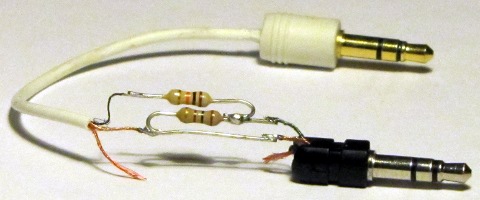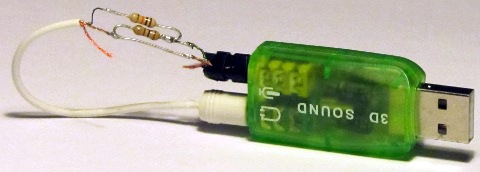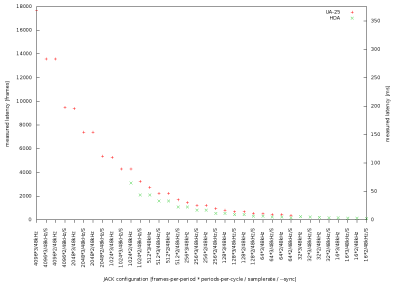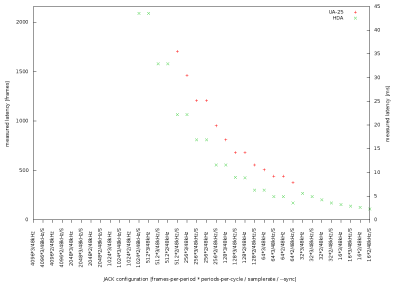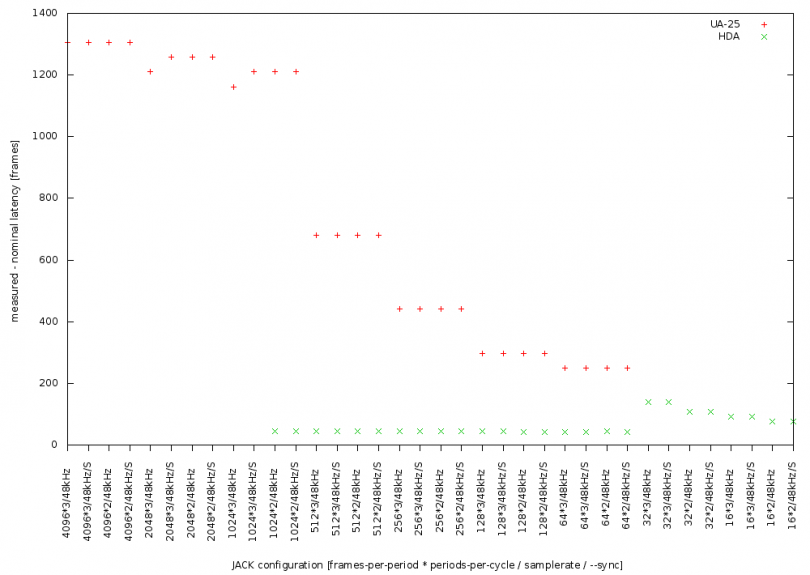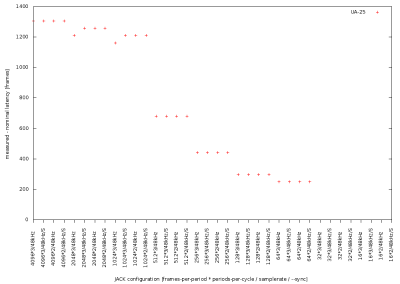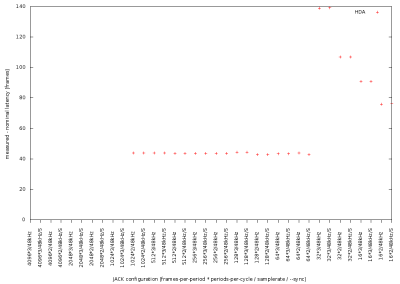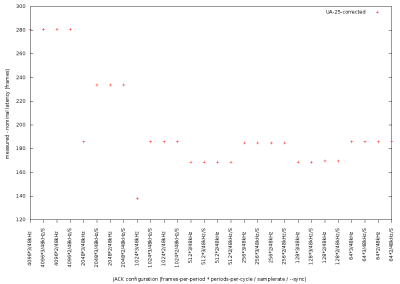Table of Contents
JACK Latency tests
Yet to be interpreted results on measuring JACK latency.
Demystifying latency
Latency is one of those buzzwords which are often misunderstood by the layman or are indiscriminately bandied around as incontrovertible proof of the evident advantages of one's own prowess against the others'. After all, it is a number you can compare with your buddies.
I once watched this guy in an audio forum talk about how he got less latency if he launched jackd from the command-line, and actually thought latency was measured by QJackCtl's DSP Load indicator, so larger audio buffers implied less latency. He was actually a nice guy trying to help, but he was rather confused himself.
So, leaving aside buzzwords, hype and urban legends, what is actually latency? Latency is how you call the reaction time of a system to a certain stimulus.
In the audio world, latency is the time elapsed between an action that produces sound and the actual perception of that sound by a listener.
A very clear case of audio latency is the time it takes to hear the sound of thunder after you watch lightning from a distant storm (actually visual perception has latency too, since light doesn't travel at infinite speed, but at that scale visual latency is negligible compared to the aural one.)
Latency sources
There are many factors that contribute to the total latency of a given system. Some of the more relevant are:
- Sound propagation through the air: since it is a mechanical perturbation in a fluid, sound travels at comparatively slow speed: about 340 m/s. Some interesting consequences:
- Your acoustic guitar or piano has a latency of about 1-2 ms, due to the propagation of the sound between your instrument and your ear .
- At a large concert venue if you are far away from the stage the sound will travel faster through the path “singer-mic-nearest loudspeaker-your ear” than through the “singer-air-your ear” one, so you'll hear the real sound as an echo of the amplified one. Relativistic time-paradox or what?
- Digital-to-Analog and Analog-to-Digital conversion: electric signals travel quite fast, so their propagation time is negligible in this context, but the conversions between the analog and digital domain take a comparatively long time to perform, so their contribution to the total latency may be considerable. Fast converters are, for instance, one of the factors that distinguishes a quality audio interface from a cheap one, along with other features like low noise, low distortion, etc.
- Digital Signal Processing: digital processors tend to process audio in chunks, and the size of that chunk depends on the needs of the algorithm and performance/cost considerations. This is usually the main cause of latency when you use a computer and one you can try to predict and optimize.
- Computer I/O Architecture: a computer is a general purpose processor, not a digital audio processor. This means our audio data has to jump a lot of fences in his path from the outside to the CPU and back, contending in the process with some other parts of the system vying for the same resources (CPU time, bus bandwidth, etc.) Thanks to the combined efforts of kernel, audio driver and jackd smart developers you are in position to tune your system a bit more towards the digital audio processing task, but don't expect miracles. Remember you can use your computer also to write documents, surf the net, save some lemmings… Polyvalence comes at a cost.
Does latency really, really matter?
Less than most people think, in our opinion. There are only some situations where a very low latency is really important, because they require very quick response from the computer. Some examples that come quickly to mind are:
- Playing virtual instruments: a large delay between the pressing of the keys and the sound the instrument produces will throw-off the timing of most instrumentalists (save if they are church organists, whom we believe are awesome latency-compensation organic systems.)
- Software audio monitoring: if a singer is hearing her own voice through two different paths, her head bones and headphones, large latencies can be disturbing.
- Live-effects: This case is similar to playing virtual instruments: instead of virtual-instruments/sythensizers it is about real-instruments and and effects processing. Low latency is important when using the computer as effect-rack (e.g. guitar effects) - also precise synchronization may be important if you trigger manually sound effects like delays.
- Live-mixing: Some sound engineers use a computer for mixing live performances. Basically that is a combination of the above: monitoring on stage, effect-processing and EQ. It is actually more tricky since one not only wants low latency (audio should not lag too much behind the performance) but exact low-latency (minimal jitter) for delay-lines between speaker in front and back.
In many other cases (such as playback, recording, overdubbing, etc.) latency is not that important or can be compensated for.
At the end of the day, it is not so much its size, but how well you use it.
The smaller the better?
TODO
Capture latency, playback latency, roundtrip latency, huh?
When you are talking about latencies it is important to be precise about where and how are they measured.
At the end of the day, what really matters is the latency perceived by the person who is using the system. But this latency is itself comprised of smaller, partial latencies. The ones that usually contribute more to the total are usually:
- Air propagation latency.
- Converter latency.
- Processing latency.
- Digital I/O latency.
There is not much we can do about the first two other than using headphones or sitting near the loudspeaker and buying quality gear.
Processing latency is usually divided into capture latency and playback latency:
- Capture latency: the time necessary for the digitized audio to be available for digital processing. Usually it is one audio period.
- Playback latency: the time necessary for the digitized audio to be processed and delivered out of the processing chain. At best it is one audio period.
But this division is an implementation detail of no great interest for the user, since one has no control over it. What really matters is the combination of both, what we could call the processing roundtrip latency: the time necessary for a certain audio event to be captured, processed and played back.
It is important to note that processing latency in a jackd is a matter of choice: we can lower it as much as we want, within the limits imposed by the audio driver. But the lower it is, the more likely our system will fail to meet it, so the dreaded xrun will make its appearance more often, leaving its merry trail of clicks, pops and crackles.
The digital I/O latency is usually negligible for integrated or PCI audio devices but, as we'll see later, it can be important for USB or FireWire interfaces.
Measuring roundtrip latency with jack_delay
jack_delay is an utility developed by Linux DSP guru Fons Adriaensen to measure the roundtrip latency of a closed loop audio chain.
jack_delay works by emitting some rather annoying tones, capturing them again after a roundtrip through the whole chain and measuring the difference in phase so it can estimate with great accuracy how long has the whole process taken. This is no theoretical estimation, jack_delay is a measuring tool that will give you the real deal.
You can close the loop on a number of ways:
- Putting a speaker close to a microphone. This is rarely done, as air propagation latency is well known so there is no need to measure it.
- Connecting the output of your audio interface to its input using a patch cable. This can be an analog or a digital loop, depending on the nature of the input/output you use. A digital loop won't factor in the converters latency.
If you want to measure the latency of a cheap, integrated sound card that only has line-output and mic-input you cannot close the loop with a simple patch cable: both connectors may be mechanically compatible, but electrically they are not designed to work together, so attempting to connect them may harm your audio interface. If you are curious, anyway, you can build a pad with a couple of resistors to adapt their impedances. Here's how we did it, but we take no responsibility for any harm your equipment might suffer. DO IT AT YOUR OWN RISK!
Some notes:
- The black plug goes into the mic outlet, so the 100 ohm resistor is in parallel with it.
- The mic ring carries a DC voltage to polarize electret microphones, so leave that wire open.
Once you have closed the loop you have to:
- Launch jackd with the configuration you want to test.
- Launch jack_delay.
- Make the appropriate connections between your jack ports so the loop is closed.
- Adjust the playback and capture levels in your mixer.
If everything goes according to plan, jack_delay should start to emit messages indicating the roundtrip delay measured both in milliseconds and in audio frames (there are SR audio frames in one second, where SR is the sample rate.)
$ jack_delay capture latency = 1024 playback_latency = 2048 Signal below threshold... Signal below threshold... Signal below threshold... 3104.419 frames 64.675 ms ?? Inv 3104.416 frames 64.675 ms ?? Inv 3104.415 frames 64.675 ms ?? Inv 3104.417 frames 64.675 ms ?? Inv
Adjusting latency
TODO
The JACK Audio Connection Kit has a few parameters to configure the latency. However the settings are constrained by hardware (audio-device, CPU and bus-speed). Lower latencies increase the load on the computer-system (it needs to process the audio in smaller chunks which arrive much more frequently). If the system can not keep up: an x-run (short for buffer over-run and buffer under-run) occurs which usually results in audible clicks or dropouts.
Low-latency is not always a feature you want to have. It comes with a couple of drawbacks: the most prominent is increased power-consumption because the CPU needs to process many small chunks of audio-data, it is constantly active and can not enter power-saving mode. Furthermore, if more than one application (sound-processor) is involved in processing the sound, the operating system performs a context-switch to run each of these for each audio-cycle which results in a much higher system-load and an increased chance of x-runs.
Stable low-latency (≤10ms) on GNU/Linux can usually only be achieved by running realtime-kernel (insert links to rtirq and setup/config info here).
JACK Latency enigma
JACK does report the port-latencies (run jack_lsp -l). However the values it reports for physical-ports are determined by the configuration (e.g. -p 1024 -n3) and do not represent the real latency.
The total latency depends on many factors: the bus (PCI, 1394, USB, Chipset), layers in between (DMA, IRQ) and of course the audio-interface itself.
On a modern computer systems all these factors plus their configuration (PCI latency, bus speed, CPU/bus freq scaling, data-packet-framing, etc) make it is close to impossible to calculate the latency introduced.
Latency measurements
Fons Adriaensen has written a utility to measure the total round-trip latency called jack_delay.
Even though the complete path of the digital audio-signal that adds latency is complicated, we do expect the additional layency to be a (more or less) constant value.
The diagrams below show the the total measured-latency for an Edirol UA-25 USB and a HDA-Intel PCI sound-card. Note that not all configurations are possible: e.g. for the USB interface the frames-per-period need to be larger or equal to 64 frames, while the HDA will not allow periods larger than 1024 frames.
The tests were done on Debian/squeeze using jackdmp 1.9.6.
Interpretation and Analysis
Let's have a closer look:
The diagrams below show the difference between the nominal-latency (given by JACK configuration - and also displayed in the qjackctl setup dialog) and the measured-latency for an Edirol UA-25 USB and a HDA-Intel PCI sound-card. In other words: it is a plot of the additional latency.
The small residue of additional non-JACK-latency for PCI devices is constant (~44 frames - .9ms). The anomalies ≤ 32 frames/period for PCI devices can be explained by bus overhead and the soundcard. However the results for USB-device is unexpected.
There are two things that the authors of this article do not understand (and may be bugs in JACK):
- It seems that for USB devices JACK secretly adds an additional period latency, but at most 1024 frames. This phenomena is not present with PCI devices.
- The latency reported by JACK is inconsistent.
The first issue was explained by ALSA developer Clemens Ladisch in this thread in jack-devel. The USB driver adds an extra period or a 24 ms buffer, whichever is smaller.
Looking closer at these two issues:
(1) plotting the non-JACK-latency for the USB device after subtracting an additional period-size - but at most 1024 frames yields a reasonable distribution:
(2) understanding the inconsistencies of reported port-latency will require digging into the source-code of JACK. Trying to reproduce this behaviour with jack-1 might also shed some light on the issue. It may also simply be a misinterpretation of the reported values. The information collected here is a first step: to make the issue clear to the authors.
using -n2 for either USB or PCI makes JACKd report during startup:
ALSA: use 2 periods for capture ALSA: use 2 periods for playback
and -n3 reports:
ALSA: use 3 periods for capture ALSA: use 3 periods for playback
while jack_lsp -l (or jack_port_get_latency) says otherwise. For -n3 -p1024:
system:capture_1
port latency = 1024 frames
system:playback_1
port latency = 2048 frames
“3 periods for capture” and “3 periods for playback” should result in the same latency for both input and output ports. Ergo, either one of the reported values is incorrect.
Alas, total latency measurement can not tell which it is.
References
- A script to acquire the data using
jack_delaycan the found atgit://rg42.org/latentoror directly: latentor.tgz.
Raw data
#UA-25, Linux 2.6.33.7-rt29 i386, jackdmp 1.9.6 #JACK-cfg, measured lat [frames], measured lat [ms], nominal latency for record [frames], nominal latency for playback [frames], periods per cycle #JACK-cfg: frames per period * periods per cycle / sample-rate / S: --sync # # values of '-1' mean that this mode is not supported # 4096*3/48kHz ,17688.747, 368.516, 4096,12288, 3 4096*3/48kHz/S ,13592.747, 283.182, 4096, 8192, 3 4096*2/48kHz ,13592.747, 283.182, 4096, 8192, 2 4096*2/48kHz/S , 9496.747, 197.849, 4096, 4096, 2 2048*3/48kHz , 9401.749, 195.870, 2048, 6144, 3 2048*3/48kHz/S , 7401.747, 154.203, 2048, 4096, 3 2048*2/48kHz , 7401.747, 154.203, 2048, 4096, 2 2048*2/48kHz/S , 5353.747, 111.536, 2048, 2048, 2 1024*3/48kHz , 5257.748, 109.536, 1024, 3072, 3 1024*3/48kHz/S , 4281.748, 89.203, 1024, 2048, 3 1024*2/48kHz , 4281.749, 89.203, 1024, 2048, 2 1024*2/48kHz/S , 3257.746, 67.870, 1024, 1024, 2 512*3/48kHz , 2728.747, 56.849, 512, 1536, 3 512*3/48kHz/S , 2216.747, 46.182, 512, 1024, 3 512*2/48kHz , 2216.748, 46.182, 512, 1024, 2 512*2/48kHz/S , 1704.748, 35.516, 512, 512, 2 256*3/48kHz , 1464.747, 30.516, 256, 768, 3 256*3/48kHz/S , 1208.748, 25.182, 256, 512, 3 256*2/48kHz , 1208.747, 25.182, 256, 512, 2 256*2/48kHz/S , 952.747, 19.849, 256, 256, 2 128*3/48kHz , 808.748, 16.849, 128, 384, 3 128*3/48kHz/S , 680.747, 14.182, 128, 256, 3 128*2/48kHz , 681.748, 14.203, 128, 256, 2 128*2/48kHz/S , 553.748, 11.536, 128, 128, 2 64*3/48kHz , 505.748, 10.536, 64, 192, 3 64*3/48kHz/S , 441.747, 9.203, 64, 128, 3 64*2/48kHz , 441.748, 9.203, 64, 128, 2 64*2/48kHz/S , 377.747, 7.870, 64, 64, 2 32*3/48kHz , -1 , -1 , 32, 96, 3 32*3/48kHz/S , -1 , -1 , 32, 64, 3 32*2/48kHz , -1 , -1 , 32, 64, 2 32*2/48kHz/S , -1 , -1 , 32, 32, 2 16*3/48kHz , -1 , -1 , 16, 48, 3 16*3/48kHz/S , -1 , -1 , 16, 32, 3 16*2/48kHz , -1 , -1 , 16, 32, 2 16*2/48kHz/S , -1 , -1 , 16, 16, 2
#HDA 1458:a002, Linux 2.6.33.7-rt29 amd64, jackdmp 1.9.6 #JACK-cfg, measured lat [frames], measured lat [ms], nominal latency for record [frames], nominal latency for playback [frames], periods per cycle #JACK-cfg: frames per period * periods per cycle / sample-rate / S: --sync # # values of '-1' mean that this mode is not supported # #2048*2 -> ALSA: cannot configure playback channel #1024*3 -> ALSA: cannot configure playback channel # 4096*3/48kHz , -1 , -1 , 4096,12288, 3 4096*3/48kHz/S , -1 , -1 , 4096, 8192, 3 4096*2/48kHz , -1 , -1 , 4096, 8192, 2 4096*2/48kHz/S , -1 , -1 , 4096, 4096, 2 2048*3/48kHz , -1 , -1 , 2048, 6144, 3 2048*3/48kHz/S , -1 , -1 , 2048, 4096, 3 2048*2/48kHz , -1 , -1 , 2048, 4096, 2 2048*2/48kHz/S , -1 , -1 , 2048, 2048, 2 1024*3/48kHz , -1 , -1 , 1024, 3072, 3 1024*3/48kHz/S , -1 , -1 , 1024, 2048, 3 1024*2/48kHz ,3115.933, 64.915, 1024, 2048, 2 1024*2/48kHz/S ,2091.965, 43.583, 1024, 1024, 2 512*3/48kHz ,2091.739, 43.578, 512, 1536, 3 512*3/48kHz/S ,1579.792, 32.912, 512, 1024, 3 512*2/48kHz ,1579.729, 32.911, 512, 1024, 2 512*2/48kHz/S ,1067.693, 22.244, 512, 512, 2 256*3/48kHz ,1067.631, 22.242, 256, 768, 3 256*3/48kHz/S , 811.610, 16.909, 256, 512, 3 256*2/48kHz , 811.640, 16.909, 256, 512, 2 256*2/48kHz/S , 555.678, 11.577, 256, 256, 2 128*3/48kHz , 556.381, 11.591, 128, 384, 3 128*3/48kHz/S , 428.372, 8.924, 128, 256, 3 128*2/48kHz , 426.775, 8.891, 128, 256, 2 128*2/48kHz/S , 298.726, 6.223, 128, 128, 2 64*3/48kHz , 299.280, 6.235, 64, 192, 3 64*3/48kHz/S , 235.297, 4.902, 64, 128, 3 64*2/48kHz , 235.833, 4.913, 64, 128, 2 64*2/48kHz/S , 170.797, 3.558, 64, 64, 2 32*3/48kHz , 267.078, 5.564, 32, 96, 3 32*3/48kHz/S , 235.163, 4.899, 32, 64, 3 32*2/48kHz , 202.842, 4.226, 32, 64, 2 32*2/48kHz/S , 170.943, 3.561, 32, 32, 2 16*3/48kHz , 155.007, 3.229, 16, 48, 3 16*3/48kHz/S , 138.963, 2.895, 16, 32, 3 16*2/48kHz , 124.041, 2.584, 16, 32, 2 16*2/48kHz/S , 108.056, 2.251, 16, 16, 2
Acknowledgments
Many thanks to Paul Davis and Stephane Letz for JACK and Fons Adriaensen for jack_delay.
This article was written by Robin Gareus and Luis Garrido and may be redistributed in terms of the GFDL.
